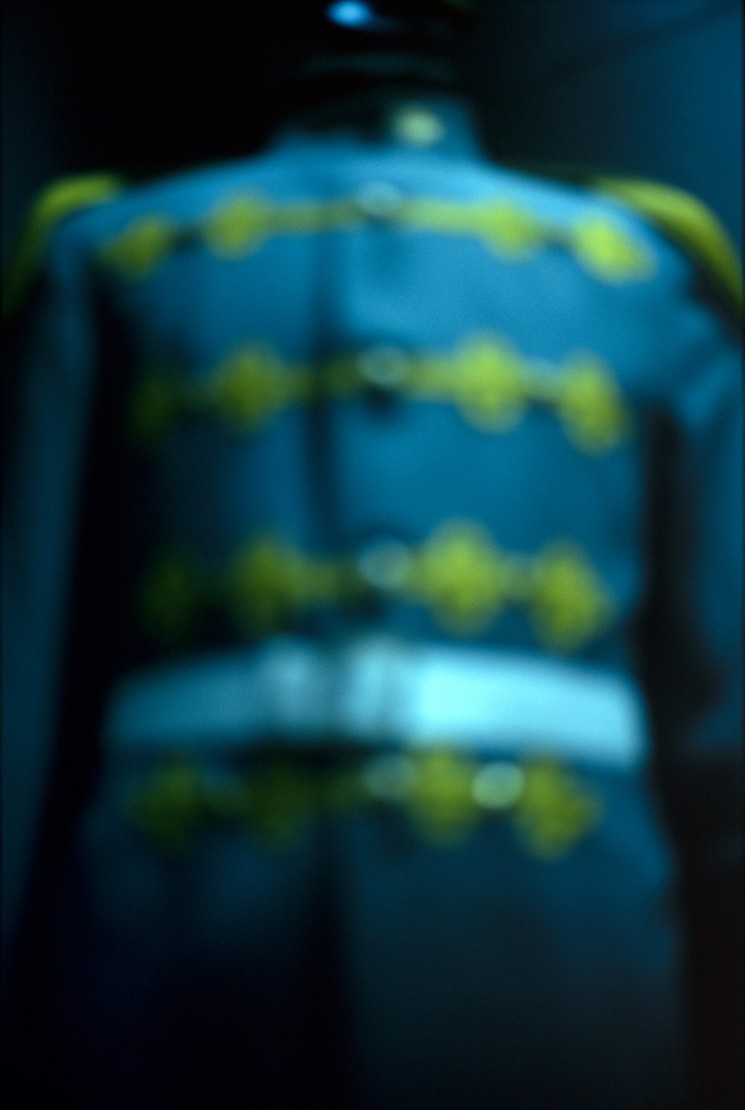Hentie van der Merwe
State President´s Guard, Riflemen

“A theme is ‘making sense’ of the violence that is such a prominent part of our society – violence invariably committed by men and how such violent acts are continuously being justified through the manufacturing of ideologies.”
The Windhoek, Namibia born artist Hentie van der Merwe (born 1972) focuses on different media such as painting, drawing and sculpture in his oeuvre but mainly his photographs have gained international recognition. He took up his education at the University of Witwatersrand and the Higher Institute for Fine Arts in Antwerp. He currently is a senior lecturer for visual arts at the University of Stellenbosch in South Africa.
The often gruesome history of Africa and the societal conflicts or contradictions as for example the role of the white man in society are core topics of his work. This is not least due to his own origin, grown up in an Africaans family in Southwest Africa. The body is a recurring motive of his works, pictured in all its vulnerability, sexuality, power, or sober objectivity. Grounds for his works are often archives or historic sites details of which influence his works.
He was dedicated singular exhibitions at the Tim van Laere Gallery, Antwerp, the Netherlands (2003/05); Goodman Gallery, Johannesburg, South Africa (2000/03); and Galerie Gabriele Rivet, Cologne, Germany (2003/04). His work was also exhibited internationally in numerous group exhibitions: “My Private Heroes”, MARTa Herford, Germany 2005; “Snap Judgements: New Positions in Contemporary African Photography”, International Center of Photography, New York, 2006; “Interpretations of Africa – Football, Art and Design”, Design Museum, London, 2011. In 2002 van der Merwe was awarded the “Prize for best visual artist” at the BIG Torini International Biennale of Young Art, which was curated by Michelangelo Pistoletto; in 2008 he received the SASOL Wax Award.
The series “Trappings” (2000/03) is van der Merwe’s best known series and includes core aspects of his work such as questions about the history of Africa that was often marked by war, forms of collective remembrance, representation or also masculinity. The viewer is confronted with life-sized uniforms of the South African armed forces of the Anglo-Boer South African war, both World Wars as well as the Angolan War from the South African Military Museum in Johannesburg. They make an almost threatening and human impression, not at last due to their enormous size, emphasized by the rather dark tones of the background, which the colourful uniforms stand out from. Van der Merwe however uses a Blur effect to undermine the authority and power of this majestic wardrobe. No details are visible. Awards and ranks fuse into colourful patterns.
In this work van der Merwe questions the schizophrenia of war. He confronts war‘s seemingly splendid and heroic side, the colourful and beautiful facades with the doubts regarding it. Uniforms are not only a reference to a certain rank or regiment but are also a symbol for a certain regime or ideology. They naturally provide the opportunity to hide insecurities and vulnerabilities, allow to forget the horrors of war as well as the physical and psychological wounds.
The art critic Rory Bester summarizes as follows, “The memories of war and the identities assumed of the men who go to war are crystallized in Trappings in ways that challenge our perceptions about military dress. The burden of war, its physical legacies in a land traumatized by a deep-seated physical and mental violence, is brought to the fore in Van der Merwe’s blurred disruptions of military dress icons. His iconoclasm is that of a white man’s guilt fishing the battles of history, battles fought, won and lost in the name of the valour of war.”